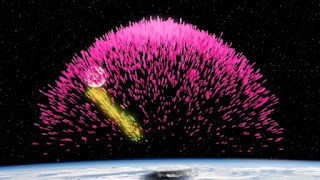Antimatter Fails Another Test
The Standard Model for the Big Bang, which has been modified with rescuing devices since its inception, is saturated with difficulties. Products of the Big Bang are expected and look good in models, but have yet to be found out in the wild.
Something that is known to people outside the secular science industry and the hallowed halls of academia is the word antimatter. Supposedly, the Big Bang produced equal amounts of matter and antimatter. All that antimatter is missing and the absence is yet to be explained.
 |
| Antimatter bursts over thunderstorm, NASA / Goddard Space Flight Center (usage does not imply endorsement of site contents) |
Secular cosmologists are still puzzling over why our universe is made primarily of matter. According to the Standard Model, the Big Bang should have produced equal quantities of matter and antimatter, which differ only in charge (e.g., a positron is a twin of an electron, but with a positive charge). Scientists at RIKEN have now run the most precise test at CERN ever done, and it failed to find any difference. “Matter and antimatter seem to respond equally to gravity,” their January 6 press release reads.
If reading the rest of the article matters to you, head on over to "Antimatter Problem Still Defies Natural Explanation."